December 2025

The healthcare automation market size is projected to reach USD 95.53 billion by 2034, expanding from USD 42.91 billion in 2025, at an annual growth rate of 9.3% during the forecast period from 2025 to 2034. The increasing adoption of digitalization, the burgeoning healthcare sector, and technological advancements drive the market.
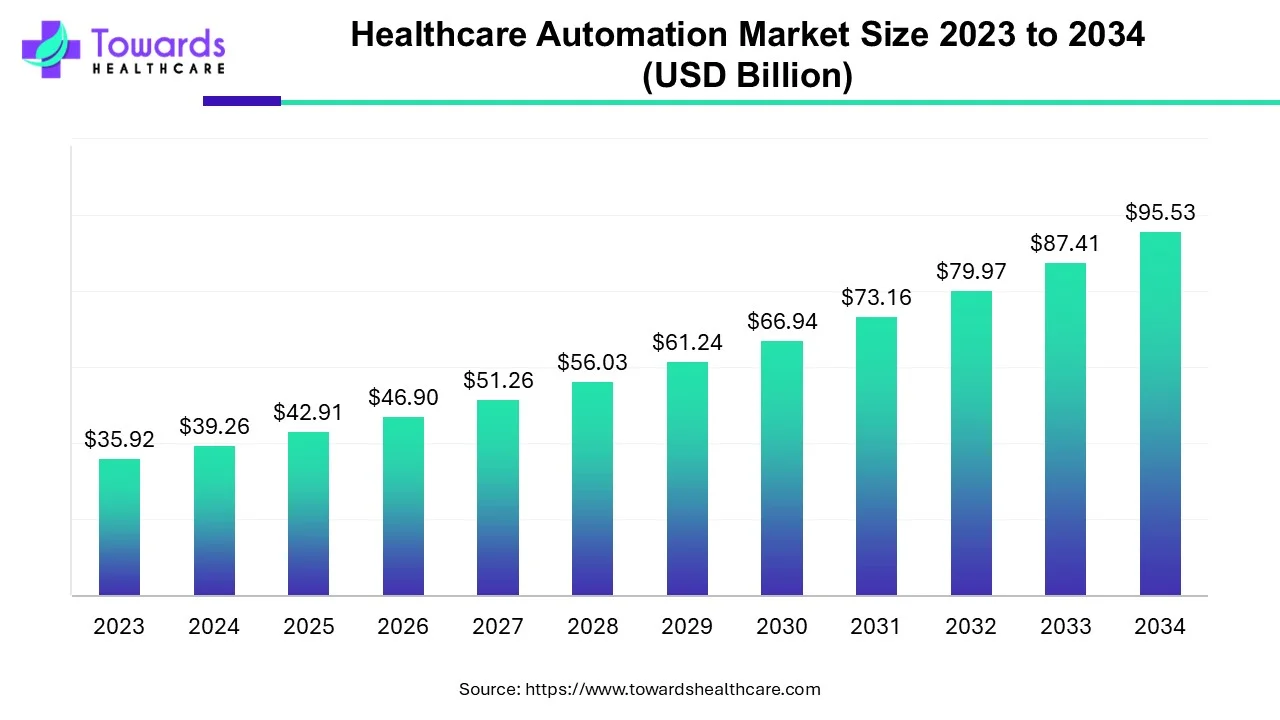
The National Cancer Institute estimates that individuals in the United States face Metastatic Breast, Prostate, Lung, Colorectal, or Metastatic Melanoma. The number of patients is expected to rise to 693,451 in 2025. Robotic Surgery has emerged as a groundbreaking approach to managing and treating the conditions, setting new standards in Cancer Treatment.
Healthcare automation is like having intelligent tools that help us in many ways. First, it can quickly find potential health issues by looking at a lot of data about a person, like genes and medical history, helping catch problems early. Then, it uses this information to create personalized plans for each person, considering their lifestyle and genes. Automation also allows monitoring patients using wearable devices and sharing real-time health data with doctors. This means people with chronic conditions can have appointments from home through telehealth, making healthcare more accessible. Automated systems also remind people to take their medicines and track them, ensuring they stay on the proper treatment. It doesn't stop there; automation can analyze data from a whole group of people to predict health trends and prevent diseases from spreading.
Additionally, it helps doctors by handling tasks like scheduling appointments and dealing with paperwork so they can spend more time caring for patients. It's crucial to use these smart tools carefully, thinking about ethics, getting permission from patients, and involving doctors in important decisions. This way, we get the best of both worlds – innovative technology and compassionate healthcare. In today's healthcare landscape, a significant focus is establishing, securing, and implementing advanced data ecosystems. The challenge lies in aggregating information from diverse sources such as medical devices and out-of-state providers, and converting it into actionable insights. This necessitates a sustained commitment to a well-thought-out data strategy.
For those who have embraced digital transformation, the next step involves identifying IT integration and interoperability weaknesses to enhance automation, analytics, and AI. Progress in digital workflows can be leveraged by transitioning from isolated solutions to contemporary data platforms, fostering integration and delivering insights that enhance workflows and, consequently, patient outcomes. Unified communication and collaboration tools are crucial, offering benefits like improved clinician satisfaction and heightened patient engagement, which are essential in overcoming staffing constraints.
Furthermore, it's noteworthy that government initiatives actively invest in healthcare automation. This strategic involvement aims to boost the overall efficiency of healthcare systems, aligning with the broader trend of leveraging technology to enhance patient care and streamline processes. Increased innovation in healthcare can lead to improved medical treatments, more efficient processes, and ultimately better patient outcomes. The demand for innovation often stems from the desire to address evolving healthcare challenges and enhance the overall quality of care.
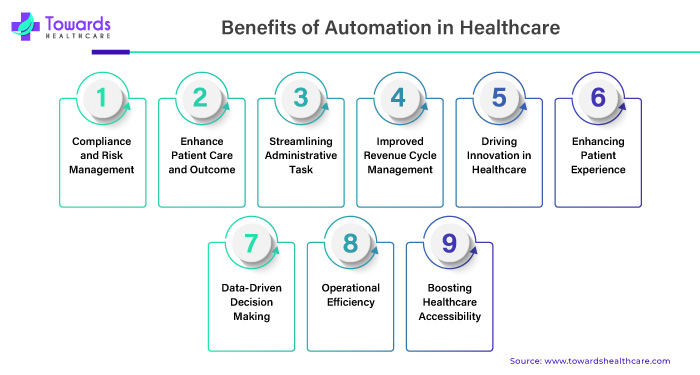
In healthcare, robotic surgery emerges as a beacon of hope, intertwining innovative technology with the tender touch of human care. The integration between surgeon and machine allows for minimally invasive surgeries, reducing recovery times and, in turn, bestowing the gift of swifter healing upon those entrusted to the operating room. It's not just about the mechanics; it's about the profound impact on lives. Robotic surgery breathes life into a future where medical interventions are practical and imbued with a sense of compassion and understanding. In the healthcare market, this technological marvel becomes a lighthouse of progress, a symbol of transformative care that reaches beyond the boundaries of what was once possible.
Automation in healthcare through robotic surgery also facilitates remote surgery, wherein a surgeon can operate on a patient in a different geographical location. This is particularly impactful for providing specialized care to remote areas or in emergencies. The robotic systems often incorporate advanced imaging and sensing technologies, providing surgeons with real-time, high-resolution visuals of the surgical site. This heightened visibility enhances decision-making and contributes to more successful outcomes.
The National Cancer Institute estimates that 18.1 million individuals in the U.S. have successfully battled cancer, with a noteworthy 67% of these survivors now aged 65 or older. Furthermore, there are roughly 623,405 people courageously navigating life with metastatic cancers such as breast, prostate, lung, colorectal or bladder cancer, along with metastatic melanoma in the United States. For patients facing the daunting journey of cancer surgery, this technology becomes a source of reassurance, promising not just treatment but an experience marked by enhanced outcomes and a path to recovery illuminated by the promise of a brighter, healthier future. Robotic surgery, in the context of cancer, transcends the clinical realm to become a compassionate ally in the fight against cancer.
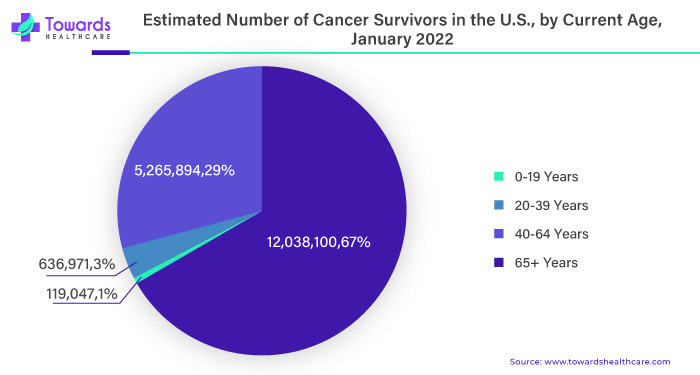
The global robotic surgery market surge results from technological advancements, a shift towards minimally invasive procedures, increased surgical capabilities, and a growing awareness and demand for innovative healthcare solutions. This trend is likely to continue as the benefits of robotic surgery become more apparent and technology continues to evolve.
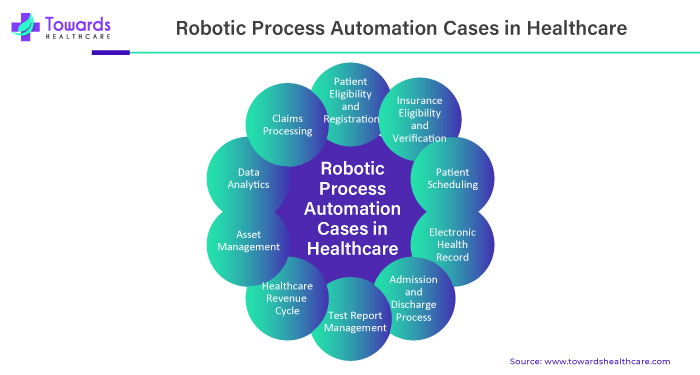
The journey towards healthcare automation is met with a formidable financial hurdle – the high initial costs. Implementing Innovation automation systems involves substantial expenses encompassing technology acquisition, training and seamless integration into existing frameworks. This financial barrier casts a looming shadow, particularly over smaller healthcare providers, potentially limiting their capacity to embrace automation solutions. The risk lies not only in the delayed progress of these providers but also in the broader market dynamics, as the collective adoption of automation could be hampered, impacting the overall growth trajectory of the healthcare automation market.
Hospital automation is like bringing intelligent helpers into a hospital to make everything smoother. It includes using fancy computer systems to handle tasks like scheduling appointments, dealing with paperwork, and managing bills. Electronic Health Records (EHRs) are like digital folders for keeping all patient info in one safe place. Imagine a system that automatically schedules your doctor visits, sends you reminders, and keeps track of all your medical records. In the pharmacy, there are fantastic machines that help with giving out the right medicines and keeping track of how much is left. Labs use automated systems to analyze samples and share results quickly. Patients are monitored using intelligent systems that monitor vital signs and alert doctors in real-time.
There's even robot assistance in surgery for super precise operations. Telemedicine brings doctors to you through video calls; inventory systems ensure the hospital has enough supplies. The goal is to make things efficient, reduce mistakes, and, most importantly, improve patients' care while remembering that the human touch is irreplaceable in essential decisions and care. Hospital automation acts as a catalyst, propelling the growth of healthcare automation on a global scale.
By integrating advanced technologies and automated systems within hospitals, we witness a transformative shift that streamlines operations and enhances the overall quality of healthcare delivery. This expansion is fueled by the seamless automation of administrative tasks, clinical processes, and patient care, improving efficiency and reducing errors. As hospitals worldwide embrace automation, they contribute significantly to the evolution of healthcare practices, ushering in an era of heightened effectiveness and innovation that transcends geographical boundaries.
By application, the therapeutic automation segment held a dominant presence in the market in 2024. Therapeutic automation refers to introducing automation in healthcare settings to revolutionize patient treatment. It enables healthcare professionals to track real-time patient data and make timely clinical decisions. Automation helps them to focus more on patient care rather than other focusing on several unimportant tasks. It transforms repetitive tasks like data entry, claims processing, and scheduling. AI and ML can also predict treatment outcomes and give prior ideas about potential adverse effects.
By application, the diagnostics & monitoring automation segment is anticipated to grow with the highest CAGR in the market during the studied years. The increasing prevalence of chronic disorders and favorable government policies drive the segment’s growth. Several organizations promote the screening and early diagnosis of chronic disorders. Integrating AI and ML into monitoring devices such as MRI, CT scans, etc., has proved to be beneficial in faster scans and enhanced diagnostic accuracy, reducing human intervention. The advent of wearable devices and smartphone apps has revolutionized the diagnostics and enabled remote monitoring. New product launches and favorable regulatory frameworks also contribute to the segment’s growth.
By end-user, the research institutes & labs segment led the global market in 2024. The growing research and development and increasing investments augment the segment’s growth. Automation can streamline the entire research process, leading to faster and more efficient outcomes. Automating tasks like sample preparation, data analysis, and liquid handling can enable researchers to focus on higher-level tasks. Additionally, it helps to maintain reproducibility in research by reducing human-induced variability and decreasing cross-contamination.
By end-user, the pharmacies segment is projected to expand rapidly in the market in the coming years. Automating numerous tasks in pharmacies is essential to provide better customer experience and stay competitive in the market. The different types of pharmacy automation solutions include storage & dispensing, compounding, packaging & labeling, data management, and analytics & reporting. The increasing number of retail and hospital pharmacies fuels the segment’s growth.
North America dominated the global healthcare automation market in 2024. The presence of key players, technological advancements, and the growing demand for enhanced patient care drive the market. Favorable government policies also support the market. The U.S. and Canadian governments support the integration of AI to introduce automation in the healthcare sector. Agencies within the U.S. Department of Health and Human Services have developed relevant regulations for healthcare automation. The increasing investments promote the market. The venture capital investments in health AI in the U.S. accounted for $11 billion in 2024. In June 2024, the Canadian government launched the “Connected Care for Canadians Act” to enable a modern, connected-care healthcare ecosystem.
Asia-Pacific is projected to host the fastest-growing market in the coming years. The increasing population and the growing demand for personalized medicines drive the market. Favorable government policies and increasing investments boost the market. The Indian government allocated a budget of Rs 89,287 crores ($10.7 billion) as part of the Union Budget 2024-25 to transform the healthcare sector through increased digital infrastructure, enhancing accessibility and innovation in healthcare services. The burgeoning healthcare sector and the increasing number of startups also contribute to market growth. There are currently more than 800 and 2,551 HealthTech startups in Japan and China, respectively.
In May 2024, China opened the world’s first AI hospital, Agent Hospital, developed by researchers from Tsinghua University with AI doctors. The AI doctors can treat 10,000 patients in just a few days, compared to two years by human doctors. The AI doctors achieved a 93.06% accuracy rate, simulating the entire process of patient care from diagnosis to follow-up.
Europe is expected to grow significantly during the forecast period. Favorable government initiatives and increasing investments are the major growth factors of the market in Europe. EU4Health and the SHAIPED project are some of the initiatives to accelerate the deployment of AI in healthcare. The rising number of startups and the presence of key players drive the market. The burgeoning healthcare sector, increasing collaboration among key players, and the growing adoption of robotic surgeries augment the market. The European government collaborates with WHO Europe, OECD, and G7 & G20 to adopt AI solutions in healthcare.
According to the International Trade Administration, Germany ranks third in the medical technology market globally after the U.S. and Japan. More than 60,000 robotic-assisted surgeries are performed annually in over 200 hospitals in Germany.
The UK government’s Medicines and Healthcare Products Regulatory Agency (MHRA) set out its “Strategic Approach to Artificial Intelligence (AI)” to provide a strategic view for incorporating AI in the field of medicine and science. The government allocated a budget of £3.4 billion in the 2024 budget to adopt the latest technology for the NHS to help doctors and nurses focus more on patients.
Alex Zekoff, Co-founder and CEO of Thoughtful AI commented on raising an investment of $20 million that the funding would enable the company to reinvest in cutting-edge research and development, make breakthrough progress in their products, hire top-tier talent, and expand their go-to-market strategy and operations. The company aims to continue innovating in the healthcare automation space, making AI integration seamless and impactful for their customers.
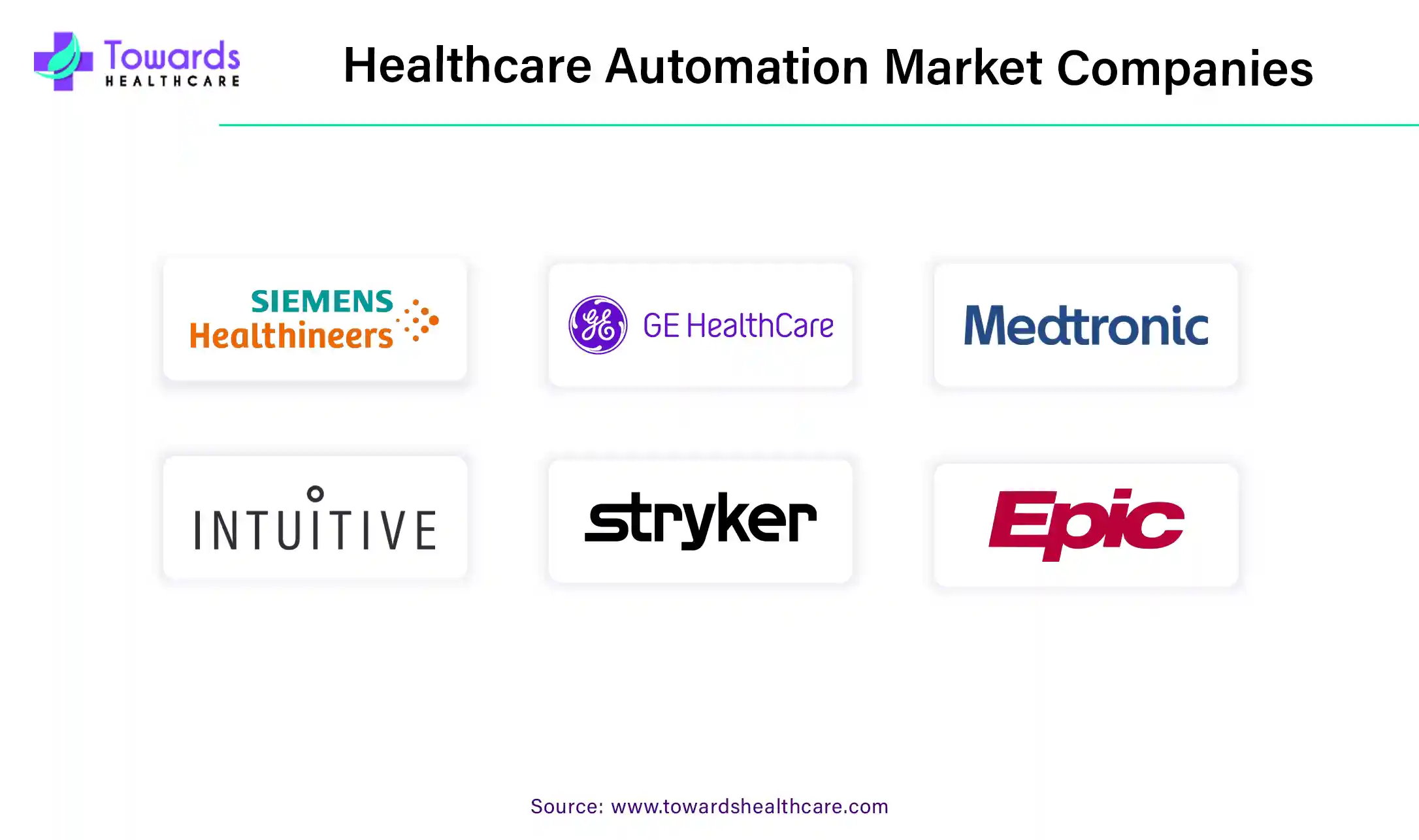
By Application
By End User
By Region
December 2025
December 2025
December 2025
December 2025